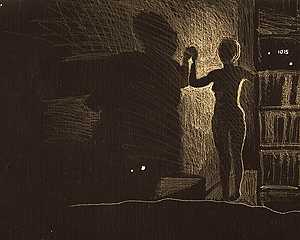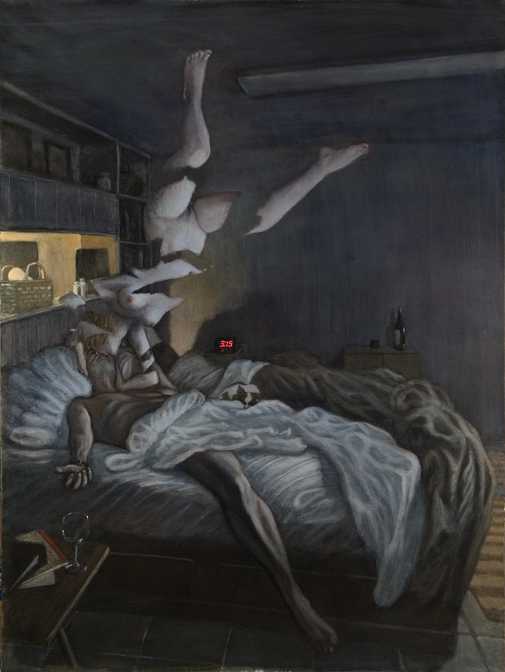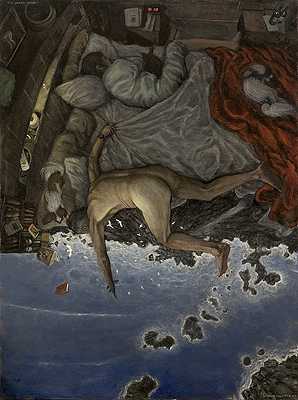|
If you missed his latest exhibit, "Warren
Criswell: Moves" at the Historic Arkansas Museum, then you
missed a look at his latest work and current obsession--animation.
And we're not talking Looney Tunes, here. Warren's animated themes
are similar to his paintings--darkly engaging and mystifying
in their portrayal of darkness and shadow. Through "The
Crow: A Fragment," an animated short based on a poem by
Wilhelm Müller and German art song "Die Kråhe"
(The Crow) by Franz Schubert, Warren explores the starkness of
nature in its pure and colorless form. He shows me a giant notebook
of hundreds of sketches comprising a total of just a few animated
minutes. "You can work all day at this and you're lucky
to get two seconds," he explains. "At 24 frames per
second, that's 48 drawings. I used to be happy with one drawing
a day!"
Warren's Arkansas story is pretty interesting.
He was an artist in Florida when he became disenchanted with
the gallery scene and put down his paintbrushes and picked up
a pen. He and his family took to the road, traveling across the
country while Warren worked on various writing projects. He was
writing a novel about the melting of the polar ice caps and the
subsequent environmental effect. Warren says he consulted a map
and decided that Little Rock might become a seaside city (or
possibly underwater) if global warming ever created a catastrophic
flood and wiped out the Gulf Coast region, so for research purposes,
he and his family headed south. Along the way, Warren discarded
his writing ambitions and began exploring art once more. "I
was written out. On the road while I was writing, I began teaching
myself watercolor, stealing time from the typewriter to play
with watercolor. Gradually the art took over," he says.
Arriving in Arkansas in the late 1970s, the Criswell family experienced
a little transportation problem-their bus broke down-so they
decided to settle in Central Arkansas, purchasing a rural piece
of property near Benton.
Once Warren began painting again, he turned
180 degrees away from his earlier style of painting. "My
writing had been autobiographical and my painting expressionistic.
I was sick of myself and wanted no trace of Criswell to show
in my new work, not even a brushstroke. I abandoned Modernism
and called myself a realist." Shortly after making Arkansas
home, Warren hooked up with Little Rock art pioneers Norman and
Helen Scott with Cantrell Gallery. "The first works they
showed of mine were photorealistic watercolors." Warren's
bright watercolor works were a hit, but by 1983 he began to feel
unfulfilled with the content and medium. "The bright sunny
watercolors became dark brooding pastels and oils-a whole different
thing," he explains. "It was Criswell coming back-like
a bad dream. My viewers didn't understand it at all and I lost
all my former collectors, but this is what it's all about--change--for
me, anyway." Warren began focusing on techniques of the
Old Masters, teaching himself how to paint in a realistic manner
that has won him notoriety and respect in the art community.
"Rembrandt, he was my guide, and I had to teach myself that
style," says Warren. "No one paints that way anymore--the
glaze and scumble thing--which I'm sure I don't do the way Rembrandt
did. I kind of concocted my own technique, but it's based on
that old-style pre-Impressionist way of painting." Through
lots of practice and research, Warren sharpened his skills and
became interested in the way the old masters created paint. "I
make most of my own paint, grinding dry pigments into oil, as
artists used to do before paint in tubes became commercially
available in the 19th century," he explains. "I store
my paint in metal tubes, however, not in pig's bladders."
Warren's preferred medium is beeswax and oil, but he's certainly
not limited to that. "Oil is the most flexible, you can
do the most with it. When I get a great idea, that's my ultimate
way to express it," he says. "But I love watercolor
and drawing in ink and chalk too. Chalk also is a throwback to
the materials Rubens and Rembrandt used. But the twist is that
I use these old fashion methods to portray our world, not theirs."
It was an exhibit of Flemish Baroque painter
Peter Paul Ruben's drawings at the Metropolitan Museum of Art
that drew him to New York City in 2004 where he unexpectedly
discovered an artist whose work inspired him, leading to his
latest artistic endeavors. "At the same time, at the same
museum, there was a show of William Kentridge's animations. I
somehow conflated those two shows and saw Reuben's drawings coming
to life," he explains. "I became obsessed with the
idea of making my drawings move!" Warren enjoys the new
medium, saying "Animation is completely different from anything
I've ever done before, and it seems like I need this kind of
renewal or rejuvenation every now and then to keep myself going."
He anticipates highlighting his films in two shows coming up
this spring. On Thursday, March 2, Warren's films will be featured
(along with other short films) at the University of Arkansas
at Little Rock. Organized by the Art Students Association, the
film night takes place the first Thursday of each month in lecture
room 161 in UALR's Fine Arts building. His work will also be
seen, along with works from 25 other artists, from May 12 to
July 9 at the Terry House Community Gallery, as a part of the
"Celebrating Excellence: Arkansas Arts Council Fellowship
Program 1986-2006" exhibit. (The Arts Council awarded Warren
a fellowship in 2003.)
I asked Warren (still in my materialistic
mindset) how he planned on marketing and profiting from what
is obviously time consuming, tedious work for just a few minutes
of art. "I need a producer or something," Warren says,
laughing. "In my mind the way I'll do this is, I'll show
paintings and drawings associated with the films and I'll have
a gallery show the film. What I'll sell are the peripherals.
There's no point in selling a digital medium because people can
copy and distribute it, but there must be some way to make money
at this," he muses.
Warren's work can be seen locally at Cantrell
Gallery and at Taylor's Contemporanea Arts in Hot Springs. (You
can also visit his website for peeks at his work and a look at
his animation, www.warrencriswell.com.)
Warren says it took him a while to find his own artistic style
and offers this advice to struggling artists: "Don't try
to be yourself, just be yourself. In my first period of painting
and at the beginning of my second I was trying to be unique,
to find something novel in subject matter and technique. It wasn't
until I gave that up--I saw it as giving up Modernism--and began
emulating the old masters that people began to say my work was
unique! I stopped having preconceived ideas about my work and
just let it happen spontaneously."
|

Nocturne,
Still #53 (from animation project) |


